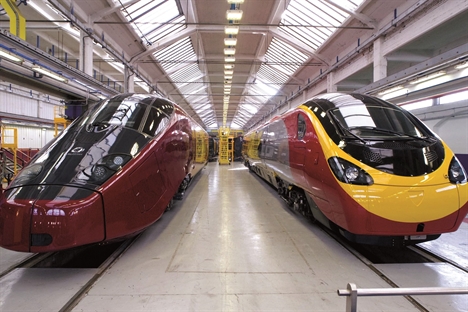01.11.15
Why three hours matters
Source: RTM Oct/Nov 2015
RTM interviews Henrik Anderberg, who took over as Alstom’s HS2 director this summer, having previously been the company’s managing director for transport in the Nordic countries.
‘Why three hours matters’ was the title of Henrik Anderberg’s talk at the recent Greengauge 21 conference in Glasgow (see opposite page). He made the case that when inter-city train journey times can be brought under this totemic benchmark, rail gains serious market share versus air.
He used data from European and Japanese high-speed rail links to make his point that there is a “cliff edge” at three hours, and told RTM later: “It takes 4h8m from Glasgow on the fastest track. Even after phase 2 of HS2, you’re only halfway to Glasgow [from London].”
The currently planned HS2 improvements will cut that to 3h38m, thanks to classic-compatible services using the existing network. Shaving that all the way down to three hours without entirely new infrastructure is difficult but not impossible, Anderberg told RTM.
“We have done simulations and, looking at it, with a combination of changes at the bottlenecks and in the infrastructure, and using tilting technology beyond Manchester, you can get to three hours.
“It’s very good to have potential alternatives. The Scottish are arguing that the best for their economy would be a full line all the way. But, if they can get the second best – using train technology, for example tilting technology, to increase speed by 25-30% in the curves in most cases, together with some minor infrastructure changes (and Network Rail knows where the bottlenecks are beyond Manchester) – it’s three hours anyway. So, maybe that could be a second-best option, if the money’s not available or the political situation is such that you will not get high-speed [track] all the way.”

Beyond the train
Alstom is best known in the UK as a train builder and maintainer, but it has extensive railway systems, electrification and infrastructure capability too, being involved (either directly or in joint ventures) on Crossrail, Edinburgh to Glasgow electrification and HS1, for example.
Asked about Alstom’s bidding intentions for HS2, Anderberg said infrastructure is as important as the rolling stock.
‘HS2 has vision’
As a relative newcomer to the UK and the debates around HS2, we asked Anderberg for his initial impressions. He said: “I had only been looking at the UK market from a distance, but being here and seeing all the projects – not only HS2 but also the ones in London, plus electrification, signalling, the conventional line upgrades, the Northern Powerhouse and everything else – is just fantastic.
“I like HS2 because it has a vision beyond the train. It’s not just a transportation system: it’s the enabler to social and economic growth. We are creating something that goes beyond just a sexy train that goes fast between A and B.
“For me it’s a chance in a lifetime to be able to participate in something truly unique.”
UK base
Anderberg said he thinks it may be mandatory for HS2’s chosen rolling stock manufacturer to build/assemble the trains in the UK, but even if not, “that’s part of our plans”. The UK and its extensive rail supply chain would be Alstom’s base for building HS2, if it won the contract.
Anderberg said that although some competitors have launched their early concept images of what their HS2 train would look like, Alstom has chosen not to until the final specification is clearer. Instead, it has been citing its capability in building high-speed trains for European networks, including the Italian AGV (pictured above, next to a Pendolino), and its mastery of tilting technology.